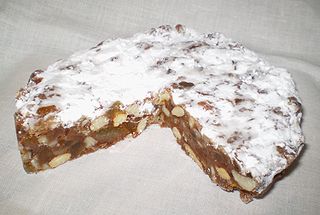
Dessert is a course that concludes a meal. The course consists of sweet foods, such as cake, biscuit, ice cream and possibly a beverage such as dessert wine and liqueur. Some cultures sweeten foods that are more commonly savory to create desserts. In some parts of the world there is no tradition of a dessert course to conclude a meal.

Confectionery is the art of making confections, which are food items that are rich in sugar and carbohydrates. Exact definitions are difficult. In general, however, confectionery is divided into two broad and somewhat overlapping categories: bakers' confections and sugar confections. The occupation of confectioner encompasses the categories of cooking performed by both the French patissier and the confiseur.

Cake is a flour confection made from flour, sugar, and other ingredients and is usually baked. In their oldest forms, cakes were modifications of bread, but cakes now cover a wide range of preparations that can be simple or elaborate and which share features with desserts such as pastries, meringues, custards, and pies.

A biscuit, in most English speaking countries, is a flour-based baked and shaped food item. Biscuits are typically hard, flat, and unleavened. They are usually sweet and may be made with sugar, chocolate, icing, jam, ginger, or cinnamon. They can also be savoury, similar to crackers. Types of biscuit include sandwich biscuits, digestive biscuits, ginger biscuits, shortbread biscuits, chocolate chip cookies, chocolate-coated marshmallow treats, Anzac biscuits, biscotti, and speculaas.

Lebkuchen, Honigkuchen or Pfefferkuchen are honey-sweetened German cakes, moulded cookies or bar cookies that have become part of Germany's Christmas traditions. They are similar to gingerbread.

Maghreb cuisine is the cooking of the Maghreb region, the northwesternmost part of Africa along the Mediterranean Sea, consisting of the countries of Algeria, Libya, Mauritania, Morocco, and Tunisia. Well-known dishes from the region include couscous, pastilla, tajine and shakshouka.

Fruitcake or fruit cake is a cake made with candied or dried fruit, nuts, and spices, and optionally soaked in spirits. In the United Kingdom, certain rich versions may be iced and decorated.

Panforte is a traditional chewy Italian dessert containing fruits and nuts. It is similar to a florentine but much thicker, or a little like a lebkuchen. Known throughout all Italy, it is a Christmas tradition associated most especially with the province of Siena.

Levantine cuisine is the traditional cuisine of the Levant, in the sense of the rough area of former Ottoman Syria. The cuisine has similarities with Egyptian cuisine, North African cuisine and Ottoman cuisine. It is particularly known for its meze spreads of hot and cold dishes, most notably among them ful medames, hummus, tabbouleh and baba ghanoush, accompanied by bread.

In many European countries, particularly in Central and Eastern Europe, there are various traditions surrounding the use of bread during the Easter holidays. Traditionally the practice of eating Easter bread or sweetened "communion" bread traces its origin back to Byzantium, Eastern Catholicism and the Orthodox Christian church. The recipe for sweetened or "honey-leavened" bread may date back as far as the Homeric Greek period based on anecdotal evidence from classical texts.

Coffee cake or coffeecake is a sweet bread common in the United States, so called because it is typically served with coffee. Leavenings can include yeast, baking soda, or baking powder. The modern dish typically contains no coffee.

Tiropita or tyropita is a Greek pastry made with layers of buttered phyllo and filled with a cheese-egg mixture. It is served either in an individual-size free-form wrapped shape, or as a larger pie that is portioned.
Armenian cuisine includes the foods and cooking techniques of the Armenian people and traditional Armenian foods and drinks. The cuisine reflects the history and geography where Armenians have lived and where Armenian empires existed. The cuisine also reflects the traditional crops and animals grown and raised in Armenian-populated or controlled areas.

Tunisian cuisine, the cuisine of Tunisia, consists of the cooking traditions, ingredients, recipes and techniques developed in Tunisia since antiquity. It is mainly a blend of Mediterranean and native Punics-Berber cuisine. Historically, Tunisian cuisine witnessed influence and exchanges with many cultures and nations like Italians, Andalusians, French and Arabs.

A sweet roll or sweet bun refers to any of a number of sweet, baked, yeast-leavened breakfast or dessert foods. They may contain spices, nuts, candied fruits, etc., and are often glazed or topped with icing. Compared to regular bread dough, sweet roll dough generally has higher levels of sugar, fat, eggs, and yeast. They are often round, and are small enough to comprise a single serving. These differ from pastries, which are made from a paste-like batter; from cakes, which are typically unleavened or chemically leavened; and from doughnuts, which are deep fried.

Bazin (Arabic: البازين, pronounced, is an unleavened bread in the cuisine of Libya prepared with barley, water and salt. Bazin is prepared by boiling barley flour in water and then beating it to create a dough using a magraf, which is a unique stick designed for this purpose. The dough may then be placed in a pan and allowed time to harden, after which it is baked or steamed. The salt contributes to the hardness of the bazin. Bazin may have a paste-like and hardened texture. It may also be prepared using whole wheat flour, olive oil and pepper as ingredients.















